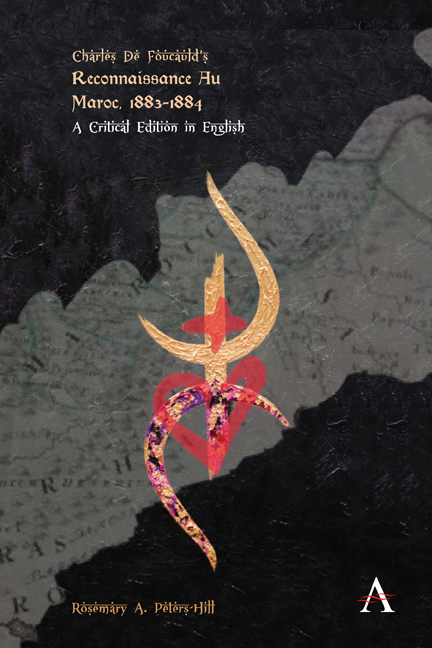Book contents
- Frontmatter
- Contents
- List of Figures
- Acknowledgments
- “There are no roads”: Charles de Foucauld’s Reconnaissance au Maroc—a Critical Introduction
- Charles de Foucauld, Reconnaissance au Maroc, 1883–1884
- Letter to François de Bondy
- Introduction
- Avant-Propos
- I Tangiers to Meknès
- II Meknès to Qaçba Beni Mellal
- III Qaçba Beni Mellal to Tikirt
- IV Tikirt to Tissint
- V Sojourn in the Sahara
- VI Tissint to Mogador
- VII Mogador to Tissint
- VIII Tissint to the Dadès
- IX The Dadès to Qçabi ech Cheurfa
- X Qçabi ech Chorfa to Lalla Maghnia
- Appendix: The Jews of Morocco
- Note on the Materials Used to Draw Up My Itinerary
- Report Delivered to the Société de Géographie de Paris in Its General Session of 24 April 1885
- “Itineraries in Morocco”
- Afterwards: An Afterword
- Glossary of Terms
- Bibliography
- Index
VIII - Tissint to the Dadès
Published online by Cambridge University Press: 20 January 2022
- Frontmatter
- Contents
- List of Figures
- Acknowledgments
- “There are no roads”: Charles de Foucauld’s Reconnaissance au Maroc—a Critical Introduction
- Charles de Foucauld, Reconnaissance au Maroc, 1883–1884
- Letter to François de Bondy
- Introduction
- Avant-Propos
- I Tangiers to Meknès
- II Meknès to Qaçba Beni Mellal
- III Qaçba Beni Mellal to Tikirt
- IV Tikirt to Tissint
- V Sojourn in the Sahara
- VI Tissint to Mogador
- VII Mogador to Tissint
- VIII Tissint to the Dadès
- IX The Dadès to Qçabi ech Cheurfa
- X Qçabi ech Chorfa to Lalla Maghnia
- Appendix: The Jews of Morocco
- Note on the Materials Used to Draw Up My Itinerary
- Report Delivered to the Société de Géographie de Paris in Its General Session of 24 April 1885
- “Itineraries in Morocco”
- Afterwards: An Afterword
- Glossary of Terms
- Bibliography
- Index
Summary
Tissint to Tazenakht
After new—but vain—efforts to reach the Drâa through Zgid, I decided to go via another route, the Tazenakht route. The road to Zgid, a challenge at all times, was impassable because of the famine ravaging the region; I could find no one to be my escort. Obliged to pass through Tazenakht, where I had already made a long stop, I resolved to take, for my return, a different route than the one I had traveled five months before. Of the three roads between Tissint and Tazenakht, I had taken the easternmost, Tizi Agni, one on my journey out; this time I chose the westernmost one, the road to Tizi n Haroun.
6 April 1884. Departure from Agadir at midnight. The Hajji, one of his brothers, and one of his cousins escort me. Mardochée is with me; we will not separate again from here to Lalla Maghnia. I cross the Feïja, passing near the ruins of Imazzen, an abandoned qçar. There is nothing more to say about this plain: still the same sands, the same gum trees. I leave the plain to follow the Oued Aginan from the point where it opens here. It is 100 meters wide, with a shingle bed, and dry. The valley floor is of a stony soil, scattered with gum trees; at first 400 meters wide, it narrows by degrees; at the same time the sides, from low black rock embankments at the beginning, become high and steep. From the Oued Aginan, I go on to one of its tributaries, the Oued Ikis, also called Ignan n Ikis, which I follow in turn. The valley is identical, but narrower. After some time, the bottom fills with crops and date-trees: a trickle of water appears; this is Tamessoult: soon I reach the houses. I stop there at seven o’clock in the morning.
Tamessoult is a large village, built of stone, halfway up the left side of the Oued Ikis, at a fair height above the riverbed. In the middle rises up the zaouïa of S. Abd er Rahman, a vast structure towered over by a dungeon: this is where I stop.
- Type
- Chapter
- Information
- Charles de Foucauld’s Reconnaissance au Maroc, 1883–1884A Critical Edition in English, pp. 317 - 332Publisher: Anthem PressPrint publication year: 2020



